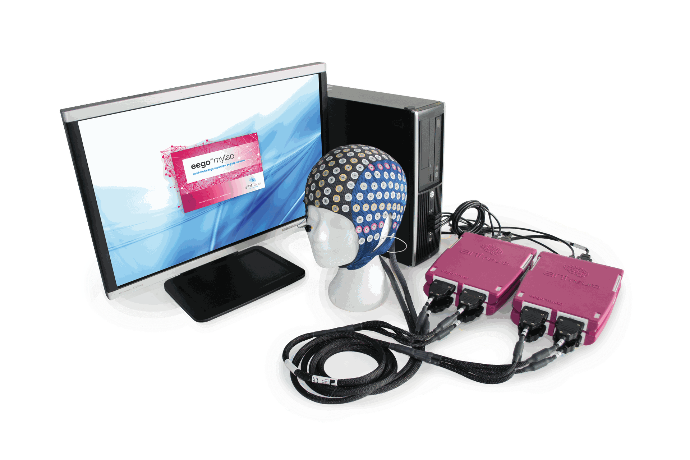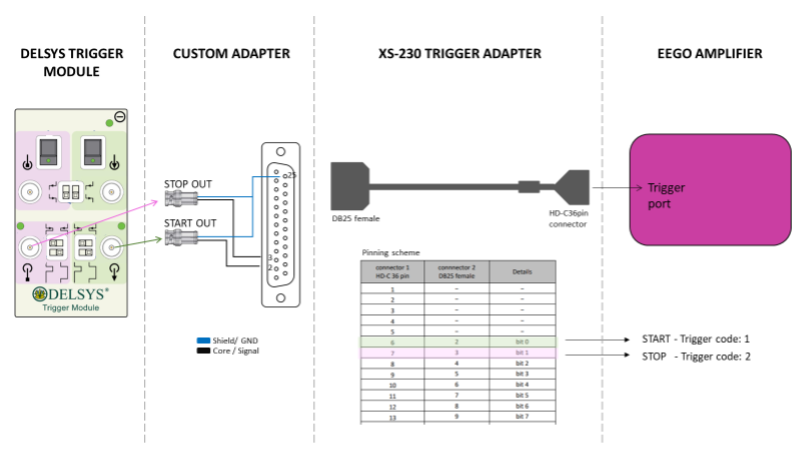An outline for setting up and synchronizing EEG recordings using the eego™ system with wireless EMG data from the Delsys Trigno® system. It covers hardware connections, synchronization methods, and practical considerations for combined EEG-EMG experiments. Applications include neurorehabilitation, sports science, and brain-muscle interaction research.
AIM
The present document illustrates how to set up a combined EEG and wireless EMG recording system. Specifically, the document outlines how to synchronize EEG data collected on eego™ with EMG data collected using the Delsys Trigno® wireless EMG system. The following sections provide an overview of the relevant fields of application, as well as schematics and detailed instructions for the correct integration of the two systems.
BACKGROUND
“Electromyography is the study of muscle function through the inquiry of the electrical signal the muscles emanate” [1]. Surface Electromyography (sEMG) is a non-invasive technique that is extensively employed in the movement sciences, engineering and neurophysiology sectors, to monitor and record the electrical activity generated by superficial muscles during movement. EMG electrodes are attached onto the skin, over the muscle of interest to capture the superimposed electrical signal from a series of motor neurons. sEMG provides valuable insights into muscle function, enabling clinicians and researchers to assess muscle health, recognize patterns in neuromuscular disorders, improve sport performance, track rehabilitation progress, enable prosthetic control and much more!
One notable advancement in sEMG technology is the development of wireless sEMG systems. These systems eliminate the need for cumbersome wired connections, offering enhanced mobility and comfort for patients and users. Wireless sEMG systems are advantageous when acquiring data because they allow the participant to move freely without being constrained by wires, resulting in a truer to life depiction of movement. This has led wireless sEMG to be popular in applications such as sports biomechanics, gait laboratories and clinical research.
Combining sEMG data with technologies like Electroencephalography (EEG), offers a deeper insight into the relationship between the brain and muscles. Through this analysis, we unveil a richer understanding of the interplay between our actions and intentions, as reflected in the data. This synergy is invaluable in fields like neurorehabilitation, where it aids in developing therapies for stroke recovery [2], assessing motor imagery in brain-computer interfaces [3], and understanding neuromuscular disorders like Parkinson's disease [4]. Additionally, sEMG finds applications in sports science, sleep research, and human-computer interaction, facilitating a deeper understanding of the intricate connections between the brain and muscles in various contexts.
SYSTEM OVERVIEW
Figure 1 shows the eego™ EEG recording system in the two main configurations: mobile (eego™ sports, to the left) and high-density/stationary (eego™ mylab, to the right). The system includes an amplifier, a cap with built-in electrodes and software for data recording and review. A physical USB connection between the eego™ amplifier and the recording device ensures reliable data transfer in all experimental scenarios. The eego™ amplifier is also equipped with an 8bit trigger port for the synchronization of EEG data with external devices via 5V TTL triggers. This trigger port is used by the Delsys system to send in triggers to the amplifier. Triggers are detected as event markers by the eego™ software during the data acquisition.

Fig 1: The eego™ EEG recording system, in the mobile 64-channel eego™sport configurations.

The eego™ EEG recording system, in the stationary, high-density 256-channel eego™mylab configuration.
The Delsys Trigno® Research System (displayed in figure 2) is a wireless biosensing device which allows researchers and clinicians to capture EMG signals from subjects. This system, with the capacity to measure up to 32 channels of data, comprises a base station and Trigno® Avanti Sensors for surface EMG + IMU measurements.

Figure 2 – The Delsys Trigno® system: Trigno® Base station (left) and Delsys Trigger Module (right).
When paired with the Delsys Trigger Module, data synchronization across different systems occurs seamlessly, ensuring precise alignment in real-time without any latency. The trigger module interfaces with an 8-bit trigger port on the base station, capable of accepting and transmitting ±5 Volt TTL pulses.
SYNCHRONIZATION SETUP
The synchronization between the eego™ and Trigno® systems can be achieved in different ways. A basic synchronization is feasible by using the standard DB25 and BNC trigger adapters provided with the eego™ system (XS-230 and XS-231):
- Synchronized Start
In this basic configuration, it is possible to simultaneously start the recording of both EEG and EMG systems. eego™ receives a trigger whenever the EMG recording is started via Trigno® software or by a button press on the Delsys trigger module. The eego™ software can be configured such that the EEG recording is also automatically started when this specific trigger code is received.
However, it is possible to achieve a higher degree of experimental control in signal synchronization. This can be done by using a custom adapter (adapter DB25 to 2x BNC. Based on XS-231), which can be employed in two main set-up configurations: - Synchronized Start/Stop
In this configuration, whenever the EMG recording is started and stopped (via Trigno® software or by button press on the Delsys trigger module), eego™ receives a corresponding trigger code (START = 1, STOP = 2). eego™ software can be configured so that EEG recording is also automatically started/stopped when these specific trigger codes are received. - Event markers
This configuration allows sending event markers (in the form of TTL triggers) from an external device (i.e. a PC delivering a visual or somatosensory stimuli, or regular synchronization triggers) to eego™ and Trigno® at the same time. This configuration requires the use of the Trigno avanti analog adapter.
The following section provides a schematic overview of the different configurations. Figures 3, 4 and 5 provide an overview of the above 3 experimental setups.
INSTRUCTIONS AND SCHEMATIC ILLUSTRATION OF THE SETUP
1- Synchronized Start
Figure 3- Configuration for synchronized start of EEG and EMG recording
STEP number |
Description |
| 1. |
Connect the Start OUT port of the Delsys Trigger Module to the Trigger port of the eego™ amplifier using the cascaded XS-230 + XS-231 adapters |
|
2. |
Select the desired pulse length by switching the START Output Pulse Length Selector on the Delsys trigger module. Note: short pulses (3μs) can only be detected if the EEG sampling frequency is set to ≥4kHz |
|
3. |
Start the recording from the Trigno® Software or by pushing the Start button on the Trigon® trigger module |
2- Synchronized Start/Stop
 Figure 4- Configuration for synchronized start/stop of EMG and EEG recordings.
Figure 4- Configuration for synchronized start/stop of EMG and EEG recordings.
STEP number |
Description |
|
1. |
Connect the two BNC connectors of the custom adapter to the START OUT and STOP OUT ports of the Delsys Trigger Module |
|
2. |
Connect the DB25 connector of the custom adapter to the trigger port of the eego™ amplifier using an XS-230 adapter |
|
3. |
Select the desired pulse length by switching the START Output Pulse Length Selector and the STOP Output Pulse Length Selector on the Delsys trigger module. Note: short pulses (3μs) can only be detected if the EEG sampling frequency is set to ≥4kHz |
|
4. |
Start the recording from the Trigno® Software or by pushing the Start button on the Trigno® trigger module |
|
5. |
Stop the recording from the Trigno® Software or by pushing the Start button on the Trigno® trigger module |
3- Event markers 
Figure 5- Configuration for synchronization of EEG and EMG data via external event markers
STEP number |
Description |
|
1. |
Connect the D25 connector of the custom adapter to the parallel port of the stimulus presentation PC |
|
2. |
Connect one of the BNC connectors of the custom adapter to the trigger port of the eego™ amplifier using the XS-230 + XS-231 adapters |
|
3. |
Connect the second BNC connector of the custom adapter to the Trigno® avanti analog adapter, using the single channel BNC connector |
|
4. |
Run the stimulation/annotation protocol on the PC to deliver synchronized TTL triggers to both systems. The TTL triggers will be recorded as event markers on eego™. On Trigno®, a dedicated analog channel will record a square wave: the first flank corresponds to the delivered trigger. |

Figure 6- Outcome of configuration 3. Each marker event in eego™ corresponds to the first flank of the square wave in Trigno
LIMITATIONS
- A known limitation of the discussed configuration is the fact that the Trigno® base station needs to be connected to power. This can introduce additional 50Hz noise in the EEG channels, which will need to be removed offline during the data processing.
- We recommend running the Trigno® acquisition software on a dedicated device (separate from the eego™ recording device). This will need to be connected via USB to the Trigno® base station (connected to power). Therefore, please note that loading everything into the eego™ sports backpack is not feasible.
- Moreover, the mobility of the system is restricted in this set-up. The main limitation is the physical connection existing between the Trigno® trigger adapter (connected to the Trigno® base station) and the eego™ amplifier. The range of motion of the participant is determined by the length of the custom trigger adapter (~5m).
- Trigno® Discover is a third-party software, EEG and EMG data are therefore not stored in the same file format for processing. The synchronization of the two signals is achieved post-hoc, based on event markers.
- The eego™ amplifier can run autonomously for approximately 5 hours. Trigno® wireless sensors last for about 6-8 h (for a single EMG channel sensor).
- When using the fast 3μs pulse option on the Trigno® trigger module, the sampling frequency on eego™ should be set to a value ≥4kHz, in order to receive the triggers accurately.
EXAMPLES OF APPLICATION FIELDS
|
Provide references to existing literature/collaborations. Brain-Muscle interaction / Postural control | |
|
Enhanced BCI | |
|
Rehabilitation robotics | |
|
Advanced gate analysis | |
|
Sport science | |
|
Sleep research |
REFERENCES
- Basmajian, J.V. and De Luca, C.J., (1985) Muscles Alive Their Functions Revealed by Electromyography. 5th edn. Baltimore: Williams and Wilkins.
- Li, H., Ji, H., et al., (2023). A sequential learning model with GNN for EEG-EMG-based stroke rehabilitation BCI. Frontiers in Neuroscience, 17, p.1125230.
- Delrobaei, M., Memar, S., Pieterman, M., et al. (2018). Surface electromyography and motor control in individuals with Parkinson's disease: Evidence of a bilateral deficit. Journal of NeuroEngineering and Rehabilitation, 15(1), 70.
- Muñoz, M. A., Miralles, J. A., Cuesta-Vargas, A. I., & Blanco, L. (2017). Use of electromyography analysis in the assessment of muscle recruitment strategies in sports. Biology of Sport, 34(3), 251-256.
DISCLAIMER
All information provided in this document is intended as a summary only.
For detailed product related information please always consult the latest version of the respective product’s user manual. This document is not intended to replace the user documentation. For indications on individual feature certification status (clinical vs. research only) please refer to the aforementioned user documentation.
We have attempted to write this document as accurately as possible. However, mistakes are bound to occur, and we reserve the right to make changes whenever needed or whenever new information becomes available.
All product names and brand names in this document are trademarks or registered trademarks of their respective holders.
© Copyright 2024 eemagine Medical Imaging Solutions GmbH.
No part of this document may be photocopied or reproduced or transmitted in any way without prior written consent from eemagine Medical Imaging Solutions GmbH.